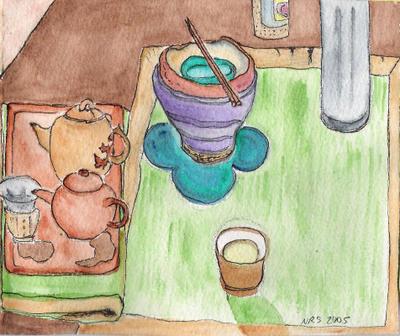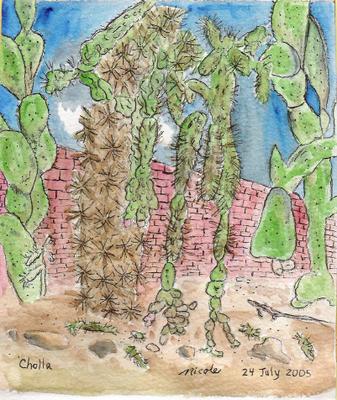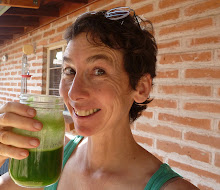
These are the dishes from my lunch today (昼ご飯 = lunch). I ate rice with furikake (ふりかけ = sprinkles of sea salt, seaweed, and sesame seed) and some strips of kim (Korean seaweed), chilled silken tofu with oshoyu (おしょう油 = soy sauce), a bowl of steamed kale drizzled with olive oil and apple cider vinegar, and Li li xiang oolong tea from Seven Cups Tea House here in Tucson. It was a delicious lunch.
おいしい (oishii).
After lunch I went on a walk with Yuki to a stand of plump cholla along the rillito. Plump and healthy from all the Spring rains and just waiting to be sketched. I saw a few little pink flowers on the cholla, but I didn't paint them. I also saw bees moving inside the flowers. We were able to walk in the middle of the day because it is cloudy today--woohoo! Relief from the summer sun.

On our way back, I saw a big bird flying from the tamarisk brush down in the rillito to a perch in a tall pine tree on the path above.
At home I consulted my trusty little bird book and found an illustration that looked like it, so I think it was a turkey vulture.
I'm having fun putting Japanese into my writing now that I figured out how to use that feature on my iBook.
楽しい -- tanoshii -- fun!
By the way, the Japanese graphic on my July 13th Pea soup entry has nothing to do with pea soup. I just wanted to see how printed plastic packaging would look scanned. The package is お祭り花火 (omatsuri hanabi) which means 'festival fireworks'. These 花火 (hanabi) were sparklers that I lit in the backyard on Fourth of July. Swirling them around was also very 楽しい。The word hanabi is 楽しい, too. It is composed of 'hana' 花 which means flower and 'bi' 火 which means 'fire'. So, 'fireworks' in Japanese is 'flower fire' 花火.


1 comment:
i love your drawings-but today's especially. i have a special thing about turkey vultures. you'll notice they seldom flap their wings. they make maximum use of the thermals to carry them forever, that is why they look at bit wobbly sometimes. their wings are lighter in color at the tips and they have a light yellow beak that can sometimes help distinguish them from a hawk if you are questioning. turkey vultures use their energy very wisely and they clean up our planet by way of eating what we don't want to see. they are also representative of very powerful mother energy. thank you so much for drawing my attention to them today!
Post a Comment